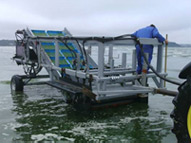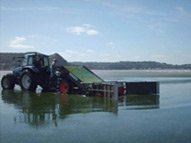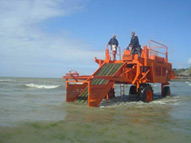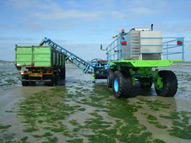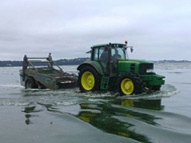Harvesting of algae
Scientific information on harvesting strategies and tools
Why harvest green algae?
The harvesting of stranded green algae has been a necessity for many years in order to limit the odor and visual nuisance they cause on the most popular beaches (green tide sheet in figures). This need has been reinforced since gases induced by the decomposition of algae have been clearly established as a health risk.
Which type of action and what are the constraints?
Three types of requirements towards harvesting are presented below, with the related constraints in implementing the action as well as the needs for technical development, particularly in the field of harvesting in the water, which requires the development of specific equipment.
- Maintain clean beaches and the most popular accesses. The harvested algae are green algae stranded on the upper fringe of the foreshore. This green biomass can be more or less mixed with other species of algae and with the sand. The frequency of this procedure is regular, more or less independent on the amount of stranded algae.
The problems to be solved with this type of action is generally related to the efficiency of the harvesting operation which is expected to produce a “clean” beach, but is also related to its selectivity with respect to the risk of removing, in the same process, natural sea debris, too much sand or pebbles. Improving the selectivity of this type of harvesting will involve a better training of local operators, through the use of efficient reamers available on the market, instead of unspecific gear commonly used today (such as seaweed harvesters). Harvesting on pebble beaches would also require specific technical adaptations, at least to preserve the tools. - Action on peak stranding events with biomass landing exceeding 1000 tons on one single site, settling at the tide scale in the upper fringe of the foreshore. These strandings are thick, clog the sediment on large surfaces, decay quickly with an ability to pollute the air over long distances and generate risks, at least in the vicinity, for human health.
The removal of this type of massive deposit requires the implementation of larger means, in areas which can be much wider than those receiving maintenance cleaning. The worksite must use heavy equipment (loaders, backhoe loaders) which, moreover, can represent an inconvenience if not a danger to manage with respect to the beach users. Such machines are naturally efficient on large accumulations of biomass and in drained swaths, but their operation, not very selective, inevitably incorporates more or less significant amounts of sand. Massive beach strandings may already contain a lot of sand at the time of their landing, but technical improvements or other intervention strategies are being sought in order to prevent removing additional sand (for example, lowering harvesting efficiency targets by leaving the lower swath layers on the ground). Better yields and better selection selectivity may also be obtained with the development of more specific harvesting tools, including equipment able to collect the thick wet deposits behind the large swaths which are only currently reachable by using conventional means.
- “Preventive” interventions have, so far, only been the subject of a limited number of experiments but are included in the Green Algae plan.
The principle of preventive harvesting is based on the assumption that clearing green algae biomass outside the optimal growth period (October to March) could, at least in some sites, reduce the level of importance of the green tide for the following year (late appearance, reducing the spring biomass peak). This hypothesis is supported by a correlation highlighted between algal surface coverage at the end of the season and the importance of the green tide spring peak event ( mechanism sheet and origin of green tides). This preventive action is targeted on the residual biomass in autumn on a site and more specifically on the biomass curtain occurring at the lower beach. The action may be supplemented by the harvesting of sporadic landings of sublittoral winter stocks.
The principle of preventive intervention to avoid the phenomenon of landing can also be applicable for massive harvesting operations during strong green tide events, for the simple purpose to partially or totally clean a site and reduce the pressure on accumulated biomass landings on the upper beach. Indeed, biomass accumulations on the upper beach has the highest health risks and can be found in areas inaccessible to deploy harvesting equipment, while these same sites can be exposed to the public.
Current knowledge on green tides describe that biomass stranding results from the combination of an excess of algae on the site and specific meteorological and tidal conditions leading to the transfer of biomass to the upper beach. Therefore, there is an absolute necessity to tackle the total stock of algae in order to reduce this stranding pressure, which means that not only action should be taken on heavy accumulations of biomass, possibly present on the upper beach and accessible to conventional equipment, but action should also be taken on the algae curtain occurring in shallow waters of the lower beach. This curtain has recently been shown to be an important and permanent reservoir for algae harvesting, providing that newly designed equipment is used.
The possibility of trawling algae in the infralittoral zone still requires huge technical, economic and environmental obstacles to overcome in order to prove its operationality, with a main technological bottleneck which prevails on the clogging of the filtration system when working with Ulva biomass, and with the need to preserve the seabed. This harvesting technique would be applicable on only some sites (which one could select by their small size and their high proportion of biomass in infralittoral zone) or as an action in support to clearing operations of sites enabling to implement any kind of available technique and for a short period.
As described for actions deployed on massive stranding events, preventive clearing operations also require to concentrate means with high harvesting yields over, as short as possible, intervention periods, and thus to combat algae growth as well as the natural recovery rate of biomass stock. As a result, the volumes of biomass removed from the beach by using such “high yield” equipment are likely to be very important (in relative proportions to the stranding) and would also require, at this level of operation, to minimize the proportion of sand taken along with the algae.
The possibility to intervene in the algae curtain on the lower beach is particularly interesting due to the amount of present and accessible biomass within the curtain on lower beach zone which stands, at any time, for a significant proportion of the total biomass, and even the unique place of their presence at the beginning of the green tide, considered on an annual scale as well as since their historical appearance on the sites. Preliminary experimental results show that potential harvesting yields are also important factors. Finally, a targeted harvesting process within the algae curtain on the lower beach seems necessary in order to respect environmental constraints for preserving the beaches towards the risk of sand removal during algae harvesting.
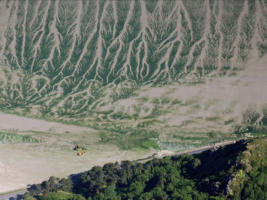 |
Harvesting zone in the Bay of Lannion – June 2010. |
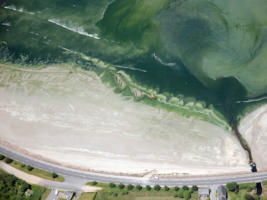 |
Harvesting zone in the Bay of Lannion – June 2010. |
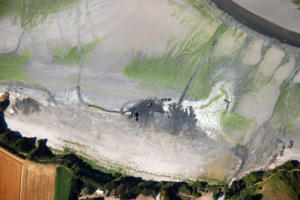 |
Harvesting zone in the Bay of St Brieuc – July 2008 |
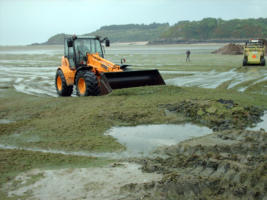 |
Harvesting zone in the Bay of la Fresnaye– May 2009 |

